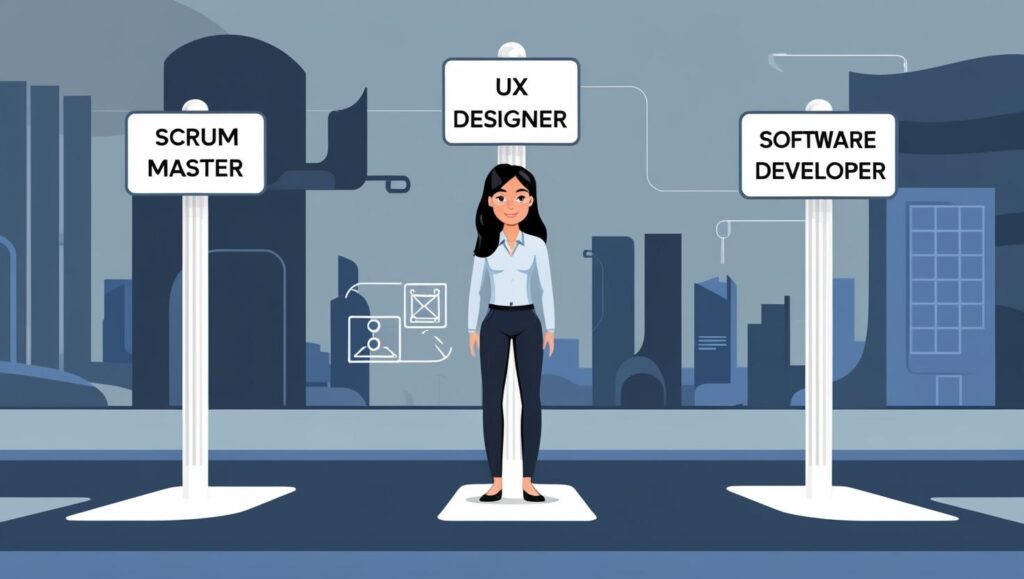
Introduction
Many testers assume QA is a one-track career where growth means either becoming a QA Lead or diving into test automation. But the reality is QA is one of the most flexible career foundations in tech.
QA professionals naturally develop skills that overlap with:
- Scrum Mastery – Facilitating Agile processes and team collaboration.
- User Experience (UX) Research & Design – Understanding usability, user pain points, and product flows.
- Software Development – Debugging, writing test scripts, and transitioning into coding roles.
If you’re thinking about career growth, this post will show how Scrum, UX, and development skills can open doors to new opportunities without leaving QA behind unless you want to.
1. QA as a Natural Fit for Scrum Master Roles
Scrum Masters don’t write code, but they are responsible for ensuring that Agile processes run smoothly. Many QA professionals already function like unofficial Scrum Masters by helping teams:
- Define acceptance criteria and testing scope for user stories.
- Facilitate retrospectives by reporting patterns in defects.
- Ensure Agile ceremonies (standups, refinements) focus on quality, not just velocity.
Why QA Professionals Transition Well Into Scrum Mastery
- Testers excel at risk assessment, making them great facilitators for sprint planning.
- QA is cross-functional. Testers interact with developers, PMs, and designers, just like Scrum Masters.
- Bug triaging and sprint retrospectives naturally prepare QA professionals for coaching teams.
If you enjoy process improvement, communication, and Agile coaching, Scrum Master might be your next step up.
At 9 AM, we’ll dive deeper into how to become a Scrum Master, including skills and certifications.
2. How QA Skills Overlap with UX Research & Design
A great tester thinks like a user, which is exactly what UX professionals do. UX and QA overlap in:
- Usability testing – Identifying user pain points that go beyond functional bugs.
- User journeys – Testing workflows with real user behavior in mind.
- Accessibility testing – Ensuring apps work for users with disabilities.
How QA Can Transition Into UX Roles
- Start participating in UX feedback sessions. QA often spots usability issues before designers do.
- Learn basic UI/UX design principles. Tools like Figma and Adobe XD help visualize user pain points.
- Partner with UX teams to conduct A/B testing and analyze usability reports.
QA professionals who love user behavior analysis may find UX design or research to be a natural career shift.
3. Why Some Testers Move Into Development Roles
Many QA professionals already know how to code, especially automation testers. Transitioning into software development is not as big a leap as it seems.
Key Skills QA and Developers Already Share
- Debugging and troubleshooting. QA testers analyze logs and errors just like developers.
- Understanding software architecture. Testers know how APIs, databases, and front-end/back-end systems interact.
- Scripting and automation. Selenium, Cypress, and Playwright scripts are close to production-level code.
How to Transition from QA to Development
- Start contributing to test automation frameworks in-depth.
- Learn development best practices by reading PR reviews and debugging failures.
- If interested, pick a programming language and gradually take on development tasks.
Many full-time developers started in QA. The technical foundation is already there.
4. Should You Leave QA for Another Role?
The biggest myth is that QA is a dead-end career. The truth? QA is a launchpad.
- If you enjoy improving team efficiency, consider Scrum Master roles.
- If you love product usability, look into UX testing or research.
- If you like coding and automation, development may be the next step.
However, QA itself is evolving. With AI testing, shift-left approaches, and DevOps integration, QA leaders are shaping the future of quality engineering.
You don’t have to leave QA to grow. Instead, expand your skill set and make yourself more valuable, whether in QA or beyond.
Conclusion
A career in QA doesn’t have to be linear. It’s one of the most versatile career paths in tech.
To maximize your career potential:
- Leverage your QA experience to explore Scrum, UX, or development roles.
- Develop transferable skills that make you indispensable to any team.
- Understand that QA is not a limitation. It’s a foundation for bigger opportunities.
At 9 AM, we’ll explore how to transition from QA to Scrum Master, including certifications, skills, and first steps.
